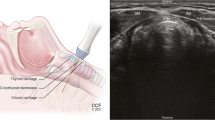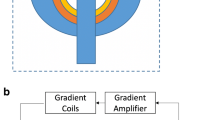Abstract
The widespread availability of ultrasound (US) technology has increased its use for point of care applications in many health care settings. Foc used (point of care) US is defined as the act of bringing US evaluation to the bedside for real-time performance. These images are collected immediately by the practitioner, allowing for direct integration into the physician’s medical decision-making process. The real-time bedside diagnostic ability of US becomes a key tool for the management of patients. The purpose of this review is to (1) provide a general description of the use of focused US for bedside procedures; (2) specify the indications and common techniques used in bedside US procedures; and (3) describe the techniques used for each bedside intervention.

















Similar content being viewed by others
References
Shojania KGDB, McDonald KM, et al., editors. Making healthcare safer: a critical analysis of patient safety practices. Rockville: Agency for Healthcare Research and Quality; 2001.
Patel PA, Ernst FR, Gunnarsson CL. Evaluation of hospital complications and costs associated with using ultrasound guidance during abdominal paracentesis procedures. J Med Econ. 2012;15:1–7.
Nicolaou S, Talsky A, Khashoggi K, Venu V. Ultrasound-guided interventional radiology in critical care. Crit Care Med. 2007;35:S186–97.
Moore CL, Copel JA. Point-of-care ultrasonography. New Eng J Med. 2011;364:749–57.
Emergency Ultrasound Guidelines. 2008. at http://www.acep.org/WorkArea/linkit.aspx?LinkIdentifier=id&ItemID=32878. Accessed 19 Sept 2014.
Randolph AG, Cook DJ, Gonzales CA, Pribble CG. Ultrasound guidance for placement of central venous catheters: a meta-analysis of the literature. Crit Care Med. 1996;24:2053–8.
Hind D, Calvert N, McWilliams R, et al. Ultrasonic locating devices for central venous cannulation: meta-analysis. BMJ. 2003;327:361.
Bahner DP, Hughes D, Royall NA. I-AIM: a novel model for teaching and performing focused sonography. J Ultr Med Off J Am Inst Ultr Med. 2012;31:295–300.
Schofer JM, Nomura JT, Bauman MJ, Hyde R, Schmier C. The, “Ski Lift”: a technique to maximize needle visualization with the long-axis approach for ultrasound-guided vascular access. Acad Emerg Med Off J Soc Acad Emerg Med. 2010;17:e83–4.
Thomas S, Moore CL. The vanishing target sign: confirmation of intraluminal needle position for ultrasound guided vascular access. Acad Emerg Med Off J Soc Acad Emerg Med. 2013;20:e17–8.
Phelan M, Hagerty D. The oblique view: an alternative approach for ultrasound-guided central line placement. J Emerg Med. 2009;37:403–8.
Wilson JG, Berona KM, Stein JC, Wang R. Oblique-axis vs. short-axis view in ultrasound-guided central venous catheterization. J Emerg Med. 2014;47:45–50.
Lewis GC, Crapo SA, Williams JG. Critical skills and procedures in emergency medicine: vascular access skills and procedures. Emerg Med Clin North Am. 2013;31:59–86.
Levy JA, Noble VE. Bedside ultrasound in pediatric emergency medicine. Pediatrics. 2008;121:E1404–12.
Tirado A, Wu T, Noble VE, et al. Ultrasound-guided procedures in the emergency department-diagnostic and therapeutic asset. Emerg Med Clin N Am. 2013;31:117.
Slawsky KMM, Goss T, Lee D. The clinical economics of ultrasound-guided procedures. Waukesha: GE Healthcare; 2011.
Moore CL. Ultrasound first, second, and last for vascular access. J Ultra Med Off J Am Inst Ultr Med. 2014;33:1135–42.
Brannam L, Blaivas M, Lyon M, Flake M. Emergency nurses’ utilization of ultrasound guidance for placement of peripheral intravenous lines in difficult-access patients. Acad Emerg Med Off J Soc Acad Emerg Med. 2004;11:1361–3.
Keenan SP. Use of ultrasound to place central lines. J Crit Care. 2002;17:126–37.
Barnes TW, Morgenthaler TI, Olson EJ, Hesley GK, Decker PA, Ryu JH. Sonographically guided thoracentesis and rate of pneumothorax. J Clin Ultr JCU. 2005;33:442–6.
Mercaldi CJ, Lanes SF. Ultrasound guidance decreases complications and improves the cost of care among patients undergoing thoracentesis and paracentesis. Chest. 2013;143:532–8.
Cavanna L, Mordenti P, Berte R, et al. Ultrasound guidance reduces pneumothorax rate and improves safety of thoracentesis in malignant pleural effusion: report on 445 consecutive patients with advanced cancer. World J Surg Oncol. 2014;12:139.
Soldati G, Smargiassi A, Inchingolo R, Sher S, Valente S, Corbo GM. Ultrasound-guided pleural puncture in supine or recumbent lateral position—feasibility study. Multidiscip Resp Med. 2013;8:18.
Mayo PH, Goltz HR, Tafreshi M, Doelken P. Safety of ultrasound-guided thoracentesis in patients receiving mechanical ventilation. Chest. 2004;125:1059–62.
Lichtenstein D, Hulot JS, Rabiller A, Tostivint I, Meziere G. Feasibility and safety of ultrasound-aided thoracentesis in mechanically ventilated patients. Int Care Med. 1999;25:955–8.
Shojaee S, Argento AC. Ultrasound-guided pleural access. Semin Resp Crit Care. 2014;35:693–705.
Nazeer SR, Dewbre H, Miller AH. Ultrasound-assisted paracentesis performed by emergency physicians vs the traditional technique: a prospective, randomized study. Am J Emerg Med. 2005;23:363–7.
Rozycki GS, Ballard RB, Feliciano DV, Schmidt JA, Pennington SD. Surgeon-performed ultrasound for the assessment of truncal injuries: lessons learned from 1540 patients. Ann Surg. 1998;228:557–67.
Runyon BA. Paracentesis of ascitic fluid. A safe procedure. Arch Intern Med. 1986;146:2259–61.
Lee TH, Ouellet JF, Cook M, Schreiber MA, Kortbeek JB. Pericardiocentesis in trauma: a systematic review. J Trauma Acute Care Surg. 2013;75:543–9.
Seferovic PM, Ristic AD, Imazio M, et al. Management strategies in pericardial emergencies. Herz. 2006;31:891–900.
Labovitz AJ, Noble VE, Bierig M, et al. Focused cardiac ultrasound in the emergent setting: a consensus statement of the American Society of Echocardiography and American College of Emergency Physicians. J Am Soc Echocard Off Pub Am Soc Echocard. 2010;23:1225–30.
Tsang TS, Barnes ME, Hayes SN, et al. Clinical and echocardiographic characteristics of significant pericardial effusions following cardiothoracic surgery and outcomes of echo-guided pericardiocentesis for management: mayo Clinic experience, 1979-1998. Chest. 1999;116:322–31.
Tsang TS, Enriquez-Sarano M, Freeman WK, et al. Consecutive 1127 therapeutic echocardiographically guided pericardiocenteses: clinical profile, practice patterns, and outcomes spanning 21 years. Mayo Clin Proc. 2002;77:429–36.
Degirmencioglu A, Karakus G, Guvenc TS, Pinhan O, Sipahi I, Akyol A. Echocardiography-guided or “sided” pericardiocentesis. Echocardiography. 2013;30:997–1000.
Royall NA, Farrin E, Bahner DP, Stawicki SP. Ultrasound-assisted musculoskeletal procedures: a practical overview of current literature. World J Orthop. 2011;2:57–66.
Dewitz AJR, Goldstein JG, Stone MB. Additional Ultrasound-Guided Procedures. In: Ma OMJ, Reardon RF, Joing SA, editors. Ma and mateer’s emergency ultrasound, 3e. New York: McGraw-Hill; 2014.
Jain AHL, Dickman E. Ultrasound-Guided Critical Care Procedures. In: DA Farcy CW, Flaxman A, Marshall JP, editors. Critical care emergency medicine. New York: McGraw-Hill; 2012.
Buckenmaier CC 3rd, Bleckner LL. Anaesthetic agents for advanced regional anaesthesia: a North American perspective. Drugs. 2005;65:745–59.
Iverson K, Haritos D, Thomas R, Kannikeswaran N. The effect of bedside ultrasound on diagnosis and management of soft tissue infections in a pediatric ED. Am J Emerg Med. 2012;30:1347–51.
Squire BT, Fox JC, Anderson C. ABSCESS: applied bedside sonography for convenient evaluation of superficial soft tissue infections. Acad Emerg Med Off J Soc Acad Emerg Med. 2005;12:601–6.
Tayal VS, Hasan N, Norton HJ, Tomaszewski CA. The effect of soft-tissue ultrasound on the management of cellulitis in the emergency department. Acad Emerg Med Off J Soc Acad Emerg Med. 2006;13:384–8.
Buckley AR, Moss EH, Blokmanis A. Diagnosis of peritonsillar abscess: value of intraoral sonography. AJR Am J Roentgenol. 1994;162:961–4.
Strong EB, Woodward PJ, Johnson LP. Intraoral ultrasound evaluation of peritonsillar abscess. Laryngoscope. 1995;105:779–82.
Loock JW. A randomised trial comparing intraoral ultrasound to landmark-based needle aspiration in patients with suspected peritonsillar abscess. Clin Otolaryngol Off J ENT UK Off J Neth Soc Oto Rhino Laryngol Cerv Fac Surg. 2013;38:245–7.
Lyon M, Blaivas M. Intraoral ultrasound in the diagnosis and treatment of suspected peritonsillar abscess in the emergency department. Acad Emerg Med Off J Soc Acad Emerg Med. 2005;12:85–8.
Tahmasebi M, Zareizadeh H, Motamedfar A. Accuracy of ultrasonography in detecting radiolucent soft-tissue foreign bodies. Ind J Radiol Imag. 2014;24:196–200.
Shrestha D, Sharma UK, Mohammad R, Dhoju D. The role of ultrasonography in detection and localization of radiolucent foreign body in soft tissues of extremities. JNMA J Nepal Med Assoc. 2009;48:5–9.
Schlager D, Sanders AB, Wiggins D, Boren W. Ultrasound for the detection of foreign bodies. Ann Emerg Med. 1991;20:189–91.
Lee YH, Baek JH, Jung SL, et al. Ultrasound-Guided Fine Needle Aspiration of Thyroid Nodules: a Consensus Statement by the Korean Society of Thyroid Radiology. Kor J Radiol Off J Kor Radiol Soc. 2015;16:391–401.
Khoo TK, Baker CH, Hallanger-Johnson J, et al. Comparison of ultrasound-guided fine-needle aspiration biopsy with core-needle biopsy in the evaluation of thyroid nodules. Endocr Pract Off J Am Coll Endocrinol Am Assoc Clin Endocrinol. 2008;14:426–31.
Frates MC, Benson CB, Charboneau JW, et al. Management of thyroid nodules detected at US: society of Radiologists in Ultrasound consensus conference statement. Radiology. 2005;237:794–800.
Nagdev ARC, Frenkel O, Mantuani. How to perform an ultrasound assisted lumbar puncture. ACEP Now 2014, p 2.
Nomura JT, Leech SJ, Shenbagamurthi S, et al. A randomized controlled trial of ultrasound-assisted lumbar puncture. J Ultra Med Off J Am Inst Ultr Med. 2007;26:1341–8.
Conflict of interest
Lydia Sahlani, Laura Thompson, Amar Vira, and Ashish Panchal declare that they have no conflict of interest.
Compliance with ethical requirements
This article does not contain any studies with human or animal subjects performed by any of the authors.
Author information
Authors and Affiliations
Corresponding author
Rights and permissions
About this article
Cite this article
Sahlani, L., Thompson, L., Vira, A. et al. Bedside ultrasound procedures: musculoskeletal and non-musculoskeletal. Eur J Trauma Emerg Surg 42, 127–138 (2016). https://doi.org/10.1007/s00068-015-0539-3
Received:
Accepted:
Published:
Issue Date:
DOI: https://doi.org/10.1007/s00068-015-0539-3




